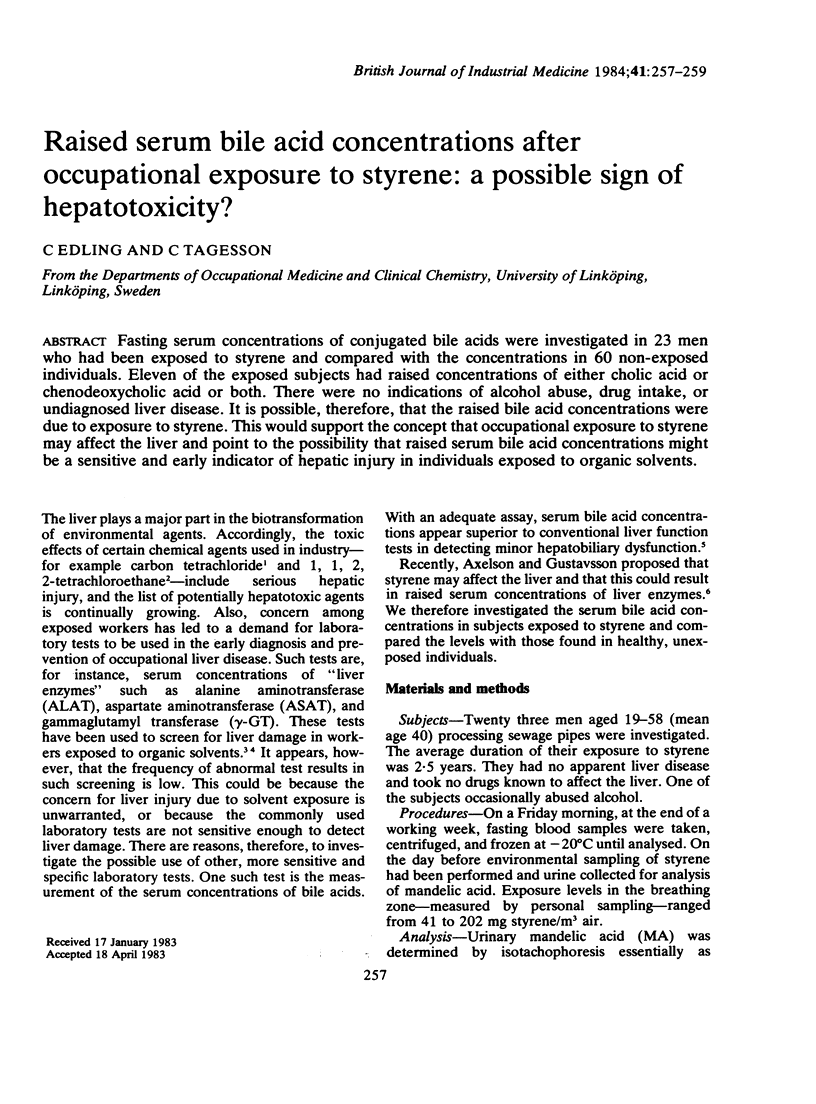Abstract
Fasting serum concentrations of conjugated bile acids were investigated in 23 men who had been exposed to styrene and compared with the concentrations in 60 non-exposed individuals. Eleven of the exposed subjects had raised concentrations of either cholic acid or chenodeoxycholic acid or both. There were no indications of alcohol abuse, drug intake, or undiagnosed liver disease. It is possible, therefore, that the raised bile acid concentrations were due to exposure to styrene. This would support the concept that occupational exposure to styrene may affect the liver and point to the possibility that raised serum bile acid concentrations might be a sensitive and early indicator of hepatic injury in individuals exposed to organic solvents.
Full text
PDF


Selected References
These references are in PubMed. This may not be the complete list of references from this article.
- Axelson O., Gustavson J. Some hygienic and clinical observations on styrene exposure. Scand J Work Environ Health. 1978;4 (Suppl 2):215–219. [PubMed] [Google Scholar]
- Cornish H. H., Adefuin J. Ethanol potentiation of halogenated aliphatic solvent toxicity. Am Ind Hyg Assoc J. 1966 Jan-Feb;27(1):57–61. doi: 10.1080/00028896609342793. [DOI] [PubMed] [Google Scholar]
- Edling C. Interaction between drugs and solvents as a cause of fatty change in the liver? Br J Ind Med. 1982 May;39(2):198–199. doi: 10.1136/oem.39.2.198. [DOI] [PMC free article] [PubMed] [Google Scholar]
- Ikeda M., Koizumi A., Miyasaka M., Watanabe T. Styrene exposure and biologic monitoring in FRP boat production plants. Int Arch Occup Environ Health. 1982 Feb;49(3-4):325–339. doi: 10.1007/BF00377941. [DOI] [PubMed] [Google Scholar]
- Kurppa K., Husman K. Car painters' exposure to a mixture of organic solvents. Serum activities of liver enzymes. Scand J Work Environ Health. 1982 Jun;8(2):137–140. doi: 10.5271/sjweh.2491. [DOI] [PubMed] [Google Scholar]
- LACHNIT V., BRICHTA G. Trichloräthylen und Leberschädigung. Zentralbl Arbeitsmed. 1958 Mar;8(3):56–62. [PubMed] [Google Scholar]
- Rosalki S. B. Gamma-glutamyl transpeptidase. Adv Clin Chem. 1975;17:53–107. doi: 10.1016/s0065-2423(08)60248-6. [DOI] [PubMed] [Google Scholar]
- Simmonds W. J., Korman M. G., Go V. L., Hofmann A. F. Radioimmunoassay of conjugated cholyl bile acids in serum. Gastroenterology. 1973 Nov;65(5):705–711. [PubMed] [Google Scholar]
- Sollenberg J., Baldesten A. Isotachophoretic analysis of mandelic acid, phenylglyoxylic acid, hippuric acid and methylhippuric acid in urine after occupational exposure to styrene, toluene and/or xylene. J Chromatogr. 1977 Feb 21;132(3):469–476. doi: 10.1016/s0021-9673(00)82910-6. [DOI] [PubMed] [Google Scholar]
- Tobiasson P., Boeryd B. Serum cholic and chenodeoxycholic acid conjugates and standard liver function tests in various morphological stages of alcoholic liver disease. Scand J Gastroenterol. 1980;15(6):657–663. doi: 10.3109/00365528009181512. [DOI] [PubMed] [Google Scholar]
- Traiger G. J., Plaa G. L. Chlorinated hydrocarbon toxicity. Potentiation by isopropyl alcohol and acetone. Arch Environ Health. 1974 May;28(5):276–278. doi: 10.1080/00039896.1974.10666486. [DOI] [PubMed] [Google Scholar]


